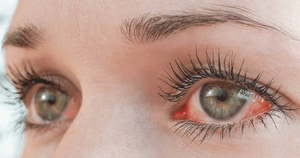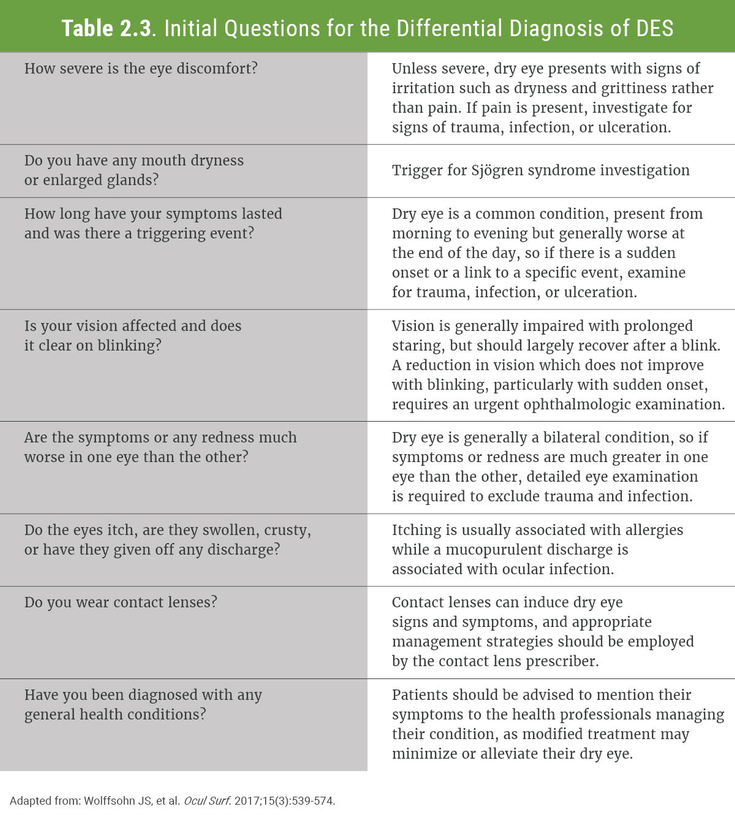Testing and Differential Diagnosis
Diagnostic Tests
If the history and symptomatology suggest dry eye syndrome (DES), the diagnosis is confirmed by objective testing for signs of DES. Historically, the Schirmer test (named after the German ophthalmologist Otto Schirmer who developed it in 1903) was most widely-used test for adequate aqueous tear production. A Schirmer paper strip (5 × 35 mm in size) is folded and attached on the temporal one-third of the lower lid margin; it becomes wetted as aqueous tears are produced. The length of the wetted part of the strip is measured after 5 minutes, and constitutes the Schirmer test score. Proposed diagnostic cut-off values range from <5 mm to <10 mm, but the test has low sensitivity and is slowly being replaced by more modern techniques for the assessment of tear volume, such as meniscometry (quantitative tear meniscus assessment).
The most commonly used indicator of tear film stability is tear film breakup time (TBUT), defined as the time interval between a complete…
To continue reading
Log in or register to continue reading. It's free!
OR
By signing up to create an account, I accept Healio's Terms of Use and Privacy Policy.
Diagnostic Tests
If the history and symptomatology suggest dry eye syndrome (DES), the diagnosis is confirmed by objective testing for signs of DES. Historically, the Schirmer test (named after the German ophthalmologist Otto Schirmer who developed it in 1903) was most widely-used test for adequate aqueous tear production. A Schirmer paper strip (5 × 35 mm in size) is folded and attached on the temporal one-third of the lower lid margin; it becomes wetted as aqueous tears are produced. The length of the wetted part of the strip is measured after 5 minutes, and constitutes the Schirmer test score. Proposed diagnostic cut-off values range from <5 mm to <10 mm, but the test has low sensitivity and is slowly being replaced by more modern techniques for the assessment of tear volume, such as meniscometry (quantitative tear meniscus assessment).
The most commonly used indicator of tear film stability is tear film breakup time (TBUT), defined as the time interval between a complete blink and the appearance of the first tear film break. This is usually assessed with sodium fluorescein instillation, with the test then called fluorescein breakup time (FBUT). In FBUT, sodium fluorescein is instilled with a micropipette or impregnated strips, and the patient is instructed to blink, after which the clinician observes the eye for tear film breakup with a blue light source (e.g., a slit-lamp) through a microscope. Depending on the volume of fluorescein instilled, the cut-off values for DES diagnosis range from <10s to <5s. Because invasive techniques such as FBUT can affect tear film stability, non-invasive methods to measure tear film stability are increasingly preferred. Many noninvasive techniques (NIBUT) are now available, and most are based on projection of a grid pattern onto the tear film and observation of its reflection (which will be distorted or blurred if there is tear film breakup); this process can be automated. Other noninvasive techniques that have been employed include high-speed videokeratoscopy (measuring video imaging variance due to tear film changes) and interferometry (measuring lipid layer discontinuities).
Ocular surface staining is a technique that can evaluate the extent of tissue injury as a consequence of DES; the micropunctate staining pattern of DES-associated tissue damage may also suggest an etiology. Staining is typically done with either sodium fluorescein or lissamine green instillation. Fluorescein will stain cells with compromised tight junctions or a defective glycocalyx, although there may be some weak signal from healthy epithelial cells. Lissamine green stains epithelial cells whose cell membrane integrity has been compromised (i.e., that are dead or degenerated).
As discussed in Overview, tear film hyperosmolarity is a core feature of DES pathophysiology. There are many commercially available, FDA-approved devices that measure the osmolarity of tear samples via a range of methods, including freezing point depression, electrical conductivity and vapor pressure osmometry. Healthy eyes maintain a stable tear film osmolarity, while eyes affected by DES rapidly lose homeostasis with environmental fluctuations. Tear osmolarity correlates well with DES severity. An osmolarity of 302.2 ± 8.3 milliosmoles per liter (mOsm/L) is classified as normal, that of 315.0 ± 11.4 mOsm/L indicates mild-moderate DES, and that of 336.4 ± 22.3 mOsm/L severe DES. A range of diagnostic cut-offs have been proposed for tear hyperosmolarity (from 305 to 316 mOsm/L), but the TFOS DEWS II proposes a value of ≥308 mOsm/L, which is widely accepted. CEDARS has proposed a slightly different severity categorization, which clinicians may find useful: 300 mOsm/L for normal, 300-320 mOsm/L for mild DES, 320-340 mOsm/L for moderate DES, and >340 mOsm/L for severe DES. Significant inter-ocular differences in tear osmolarity are also suggestive of DES.
Certain newer tests can detect the presence and activity of matrix metalloproteinase (MMPs) in the tear film, a key feature of the core pathophysiological cycle of DES (see Overview). Tight junction proteins are targeted by MMPs, degrading the ocular epithelial barrier and leading to further film instability. Point-of-care tests that can measure MMP-9 activity levels are now commercially available (e.g., InflammaDry®). However, it is important to note that such tests only indicate the presence of inflammation and are not etiologically specific. Nevertheless, a positive result (≥40 ng/ml) can inform management (e.g., use of topical anti-inflammatory agents).
In addition to the tests described above and similar techniques, a clinical assessment of suspected DES should include an evaluation of facial and eyelid skin (for dermatological conditions associated with eye inflammation), eyelid anatomy (contour, position, closure completeness) and an assessment of the conjunctiva and cornea. Serologic testing is indicated in patients with suspected autoimmune conditions (see Comorbidities).
TFOS DEWS II Diagnostic Criteria
According to the TFOS DEWS II, a formal diagnosis of DES requires both of the following:
- Positive symptomatology, indicated by either of the following:
- An OSDI score of ≥13
- A DEQ-5 score of ≥6
- An indication of disrupted tear film homeostasis, indicated by one of the following:
- TBUT of <10 seconds, assessed by FBUT or NIBUT
- Tear osmolarity ≥308 mOsm/L in either eye or an inter-ocular difference of >8 mOsm/L
- Any of the following ocular staining results:
- >5 corneal spots
- >9 conjunctival spots
- Lid margin (≥ 2 mm length and ≥25% width)
Differential Diagnosis
The differential diagnosis of DES includes conjunctivitis (allergic, toxic, or infectious), superior limbic keratoconjunctivitis, anterior blepharitis, Demodex infestation, trachoma, rheumatological conditions, and non-DES corneal, conjunctival and lid-related abnormalities. The questions presented in Table 2-3 are helpful to distinguish DES from its mimics.
References
- Bron AJ, de Paiva CS, Chauhan SK, et al. TFOS DEWS II pathophysiology report [published correction appears in Ocul Surf. 2019 Oct;17(4):842.
- Chalmers RL, Begley CG, Caffery B. Validation of the 5-Item Dry Eye Questionnaire (DEQ-5): Discrimination across self-assessed severity and aqueous tear deficient dry eye diagnoses. Cont Lens Anterior Eye. 2010;33(2):55-60.




